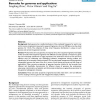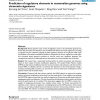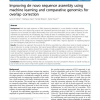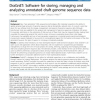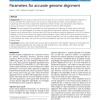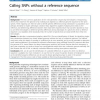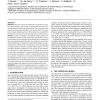BMCBI
2008
13 years 4 months ago
2008
Background: Each genome has a stable distribution of the combined frequency for each k-mer and its reverse complement measured in sequence fragments as short as 1000 bps across th...
BMCBI
2008
13 years 4 months ago
2008
Background: Recent genomic scale survey of epigenetic states in the mammalian genomes has shown that promoters and enhancers are correlated with distinct chromatin signatures, pro...
BMCBI
2010
13 years 4 months ago
2010
Background: With the rapid expansion of DNA sequencing databases, it is now feasible to identify relevant information from prior sequencing projects and completed genomes and appl...
BMCBI
2010
13 years 4 months ago
2010
Background: S. cerevisiae, A. thaliana and M. musculus are well-studied organisms in biology and the sequencing of their genomes was completed many years ago. It is still a challe...
BMCBI
2010
13 years 4 months ago
2010
Background: New "next generation" DNA sequencing technologies offer individual researchers the ability to rapidly generate large amounts of genome sequence data at drama...
BMCBI
2010
13 years 4 months ago
2010
Background: Genome sequence alignments form the basis of much research. Genome alignment depends on various mundane but critical choices, such as how to mask repeats and which sco...
BMCBI
2010
13 years 4 months ago
2010
Background: The most common application for the next-generation sequencing technologies is resequencing, where short reads from the genome of an individual are aligned to a refere...
BIOINFORMATICS
2008
13 years 4 months ago
2008
Background: A common approach to understanding the genetic basis of complex traits is through identification of associated quantitative trait loci (QTL). Fine mapping QTLs require...
BIOINFORMATICS
2007
13 years 4 months ago
2007
Motivation: Genome maps are fundamental to the study of an organism and essential in the process of genome sequencing which in turn provides the ultimate map of the genome. The in...
BIB
2007
13 years 4 months ago
2007
The contribution of transposable elements (TEs) to genome structure and evolution as well as their impact on genome sequencing, assembly, annotation and alignment has generated in...
